After a stunning start to his time as Manchester United’s interim manager, Ole Gunnar Solskjær has faced an extremely difficult spell with United in catastrophic form.
In fact, ever since his spell in charge was made permanent, United have conceded a lot of goals.
This will be the focus of this tactical analysis as I’ll highlight Manchester United’s defensive problems and why Solskjær needs to improve the defensive structure of his side to solve these problems.
The situation: Statistics
It’s been clear lately that United have defended very poorly compared to only six weeks ago.
The statistics back this up; in Solskjær’s first nineteen games in charge, United conceded seventeen goals.
In the eight since his appointment was made permanent, they’ve conceded sixteen.
They kept seven clean sheets in those first nineteen games compared with none after Solskjær became the permanent manager during the international break in March.
It seems incredible that a team that impressed defensively and kept clean sheets against Chelsea and Liverpool now find themselves consistently being played right through the spine of their team.
Teams like West Ham, Watford and Wolves have all deserved to score more than they have in games against United.
It’s not like United have been exploited for being a lot more attacking and looking to outscore the opponent, as United are without a goal in open play for about a month, but United have simply been extremely poor both in attack and in defence.
Tactical analysis: Where is Ole Gunnar Solskjær’s Manchester United going wrong?
United probably do their analysis well after games, but still, they haven’t eradicated their structural issues defensively.
These issues include too much space given to opponents between United’s midfield and defence, man-orientated marking dragging players out of position and horrible, reactive positioning around the box.
Let’s look at a few examples of this below.
Spaces between the lines
Anyone who has ever coached or played football knows that you need to protect the space between your defensive and midfield lines.
This is especially true against teams like Barcelona.
In the image below, I’ve highlighted United’s defensive setup just before Coutinho made it 3-0.
Lionel Messi is on the ball in midfield and plays a sweeping pass out to Jordi Alba.
He could, though, just as easily have threaded it into Coutinho or Luis Suárez who are positioned between United’s defence and midfield.
The central midfield duo of Fred and McTominay both push towards the ball while the defence drops, creating that huge space between the lines.
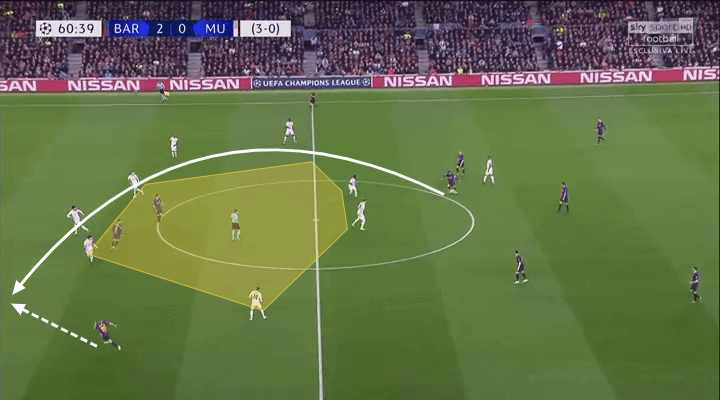
Alba has just played the ball back to Coutinho (yellow).
Lindelöf, Smalling and Jones have all dropped while left-back Ashley Young has been to slow to retreat.
The same goes for Fred in midfield.
This means Barca are actually 3 vs 3 against United’s remaining defenders just outside the penalty area after just two passes from their own half.
Young’s positional weakness is highlighted here as he should have dropped alongside his fellow defenders and been somewhere around where I’ve put the empty white circle.
Then United would have been 4 vs 3 and could have let Smalling step out to Coutinho.
Now they can’t and Coutinho has enough time to score beautifully.
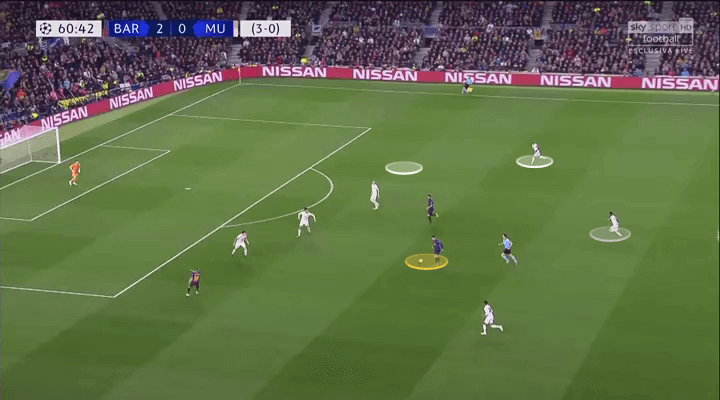
This is just one example but United consistently give up space between the lines and allow teams time on the ball just outside their own penalty area.
This is due to the poorly synchronised collective movements out of possession, and the individual mistakes in terms of basic positioning made by so many of their defenders and central midfielders.
Horrible positioning around the box
However, what perhaps is most startling for a team at United’s level is the horrible positioning around their penalty area.
What I’ll look at now is truly amateur stuff.
It seems laughable when you remember this team defended so well positionally as a collective at home against Liverpool and away to Chelsea and PSG.
Let’s start with a situation from the Manchester derby last week.
Raheem Sterling has the ball and is up against Young.
You can see United’s back-five in pretty good positions at this point.
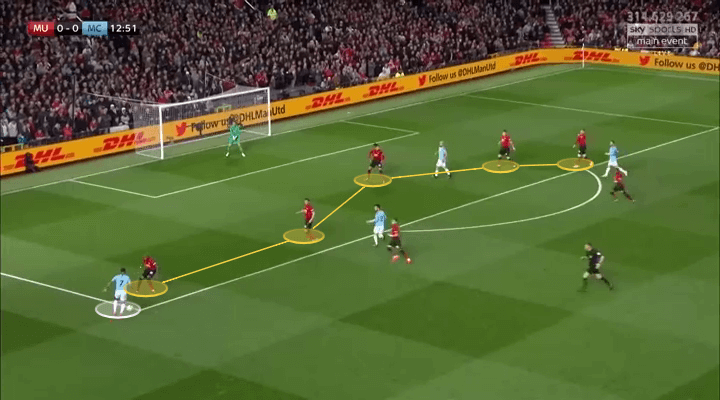
In the image below, Sterling has now started to drive infield.
Young (white) should just pass him onto Pereira (yellow) at this point.
United are still in good positions to defend at this point with seven players behind the ball.
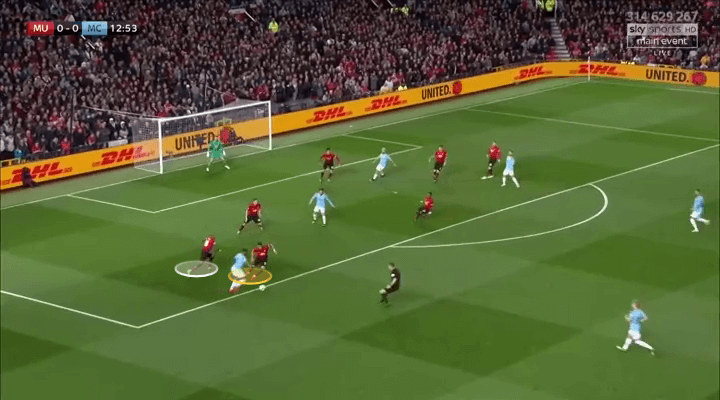
As you see below, Pereira has been easily beaten.
Young has continued to follow Sterling’s run inside and now looks to put pressure on the winger.
Please have a look at United’s back-five.
It’s possible that you’ve never seen a back-five in these positions.
Look at Smalling in particular who has dropped four yards deeper than his fellow centre-backs and plays Agüero and Silva onside.
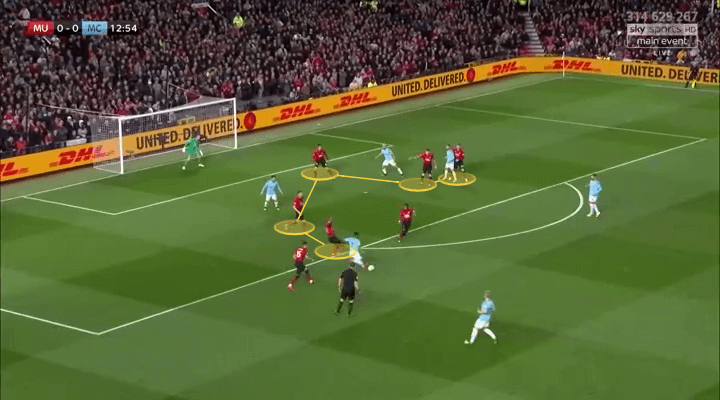
As Sterling plays the ball to Gündogan, the German has a great chance to play a one-touch pass to David Silva who is onside all alone just in front of goal due to Smalling’s ridiculous positioning.
United were lucky that he didn’t see this pass.
If he had, Silva and Agüero would be 2 vs 1 against Smalling just outside the six-yard box.
United have nine players here in the central area of the pitch but are poorly positioned as a collective.
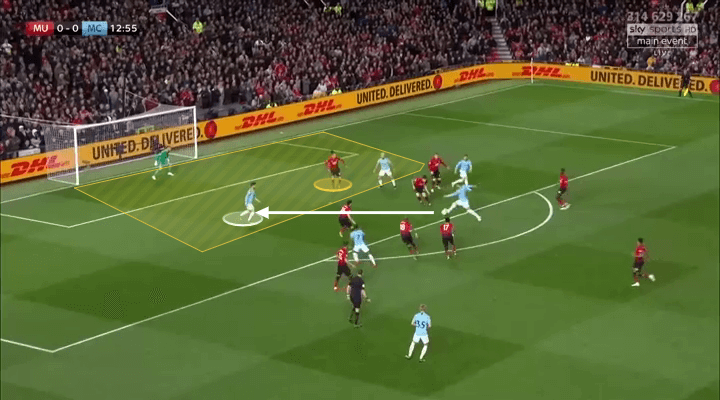
United’s defensive players are consistently guilty of chasing the ball rather than keeping their positions around the box.
The game against Watford provided plenty of examples of this.
The image below highlights Roberto Pereyra as he has just received the ball.
Young (white) is immediately attracted to the Argentinian.
Smalling (blue) decides to pick up the run from Deulofeu into space behind Young.
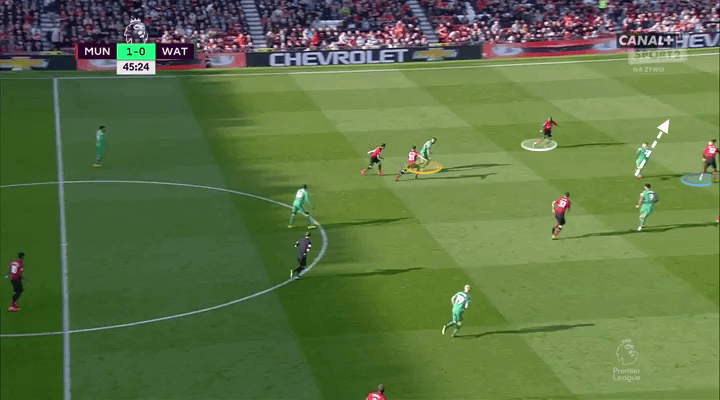
Preferably, Young would have stayed in position, allowed Smalling to step up and picked up the run of Deulofeu.
As it was, they changed positions.
As the image below shows, this is still no issue.
Smalling (yellow) provides pressure on the ball while Young (white) covers in as a centre-back.
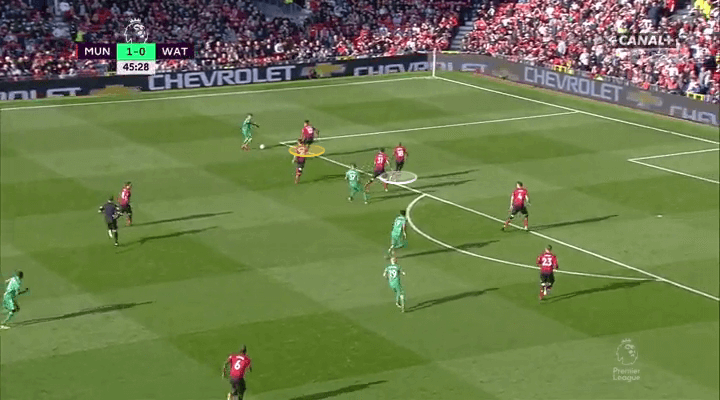
This is where the ridiculousness kicks in again.
The ball is played inside to Pereyra (blue) again.
Smalling is still wide right having pressed Deulofeu.
Young steps up to Pereyra.
Nemanja Matić (black), United’s defensive midfielder, has now decided to leave his position and move very deep alongside Jones.
When Will Hughes makes a run into this vacated space centrally, United’s left-back Luke Shaw (yellow) makes an unexplainable decision.
He leaves his position (empty yellow circle) to mark Hughes.
As Abdoulaye Doucouré makes a run into this space, Paul Pogba (white) is forced to go with him.
So, rather than Shaw staying in his position and Pogba in his, United now have Shaw in central midfield and Pogba at left-back.
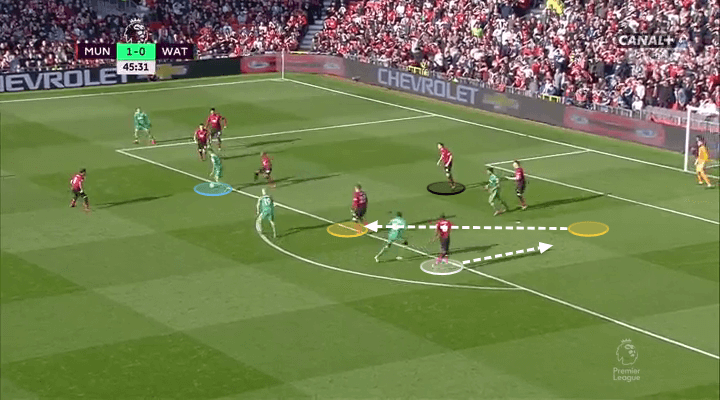
The ball is transferred to Deulofeu who cuts inside.
As you see below, United have now a situational back-six.
It reads, from right to left, Smalling-Young-Matić-Shaw-Jones-Pogba.
With Herrera pressing Deulofeu, United have NO ONE defending the space outside the box.
This is spectacularly unorganised at a level I’ve rarely seen at any level.
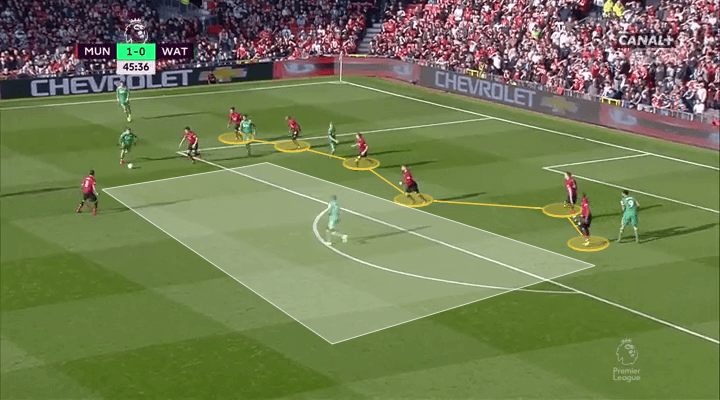
Luke Shaw has impressed with his individual defending in many games.
His positional sense, however, leaves a lot to be desired.
The image below highlights this perfectly well.
For some reason, he has decided to mark Hughes four yards behind the rest of his teammates.
As Jones, Young and Smalling have all changed positions in this situation, United are already disorganised.
Shaw’s position means United have no cover on their left.
Shaw should be somewhere around where I’ve put the black circle.
Now, United have no player defending the left half of their penalty area and Watford create a chance from which Janmaat should have done better.
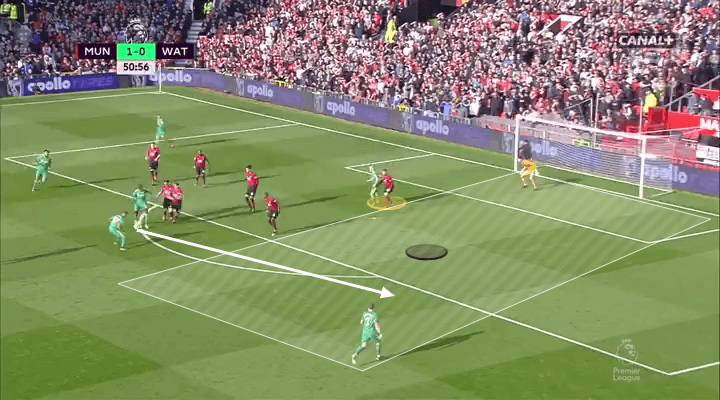
Finally, United also showcased these positional issues against West Ham.
The image below shows the build-up for West Ham’s goal.
At first, United’s defenders are in decent positions.
Smalling (white) provides pressure on the ball while the other three provide cover behind him.
Preferably, I’d have liked Jones a bit deeper, in the black circle, but it’s still a decent setup.
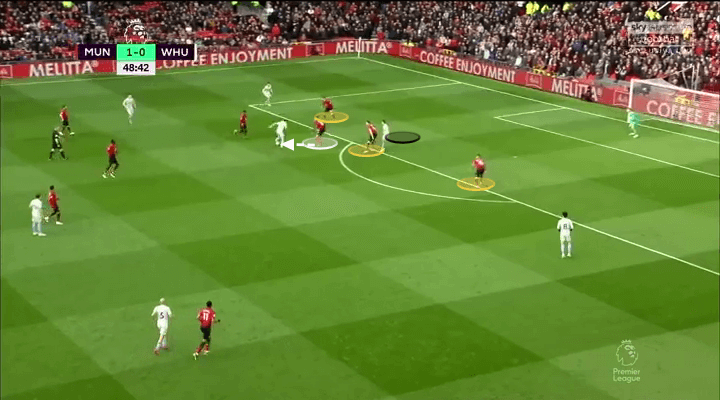
What then happens is symptomatic of United’s structural positional issues around their own box.
As you see below, Smalling (white) now provides cover for Dalot as Lanzini has received the ball on West Ham’s left.
This job should be done by Fred or Mata.
Smalling, as the ball-near centre-back, should move back into the position highlighted to defend the first-post area.
This would allow Jones to defend the middle of the goal and Rojo the back-post area.
Mata and Pogba are too lazy to get back into the correct positions.
This leaves United defending the cross 2 vs 2 when they should always have a numerical advantage in their own box.
As it happens, Rojo’s individual defending is perhaps even worse than the collective as he allows Anderson to get to the cross first despite spending eight seconds looking straight at the Brazilian.
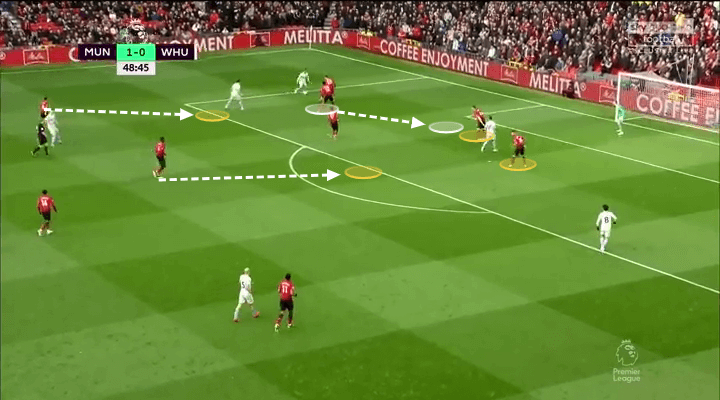
Man-orientated defending causing issues
When United enjoyed a good run and defended really well, they did so with an organised positional approach where each player kept their position rather than marking the closest opponent.
Recently, however, the old Mourinho habits of chasing the ball and opponents have crept back into the players with plenty of them now making consistently poor decisions when defending.
Let’s have a look at Manchester City’s second goal in the derby as an example.
In the image below we can see how Sterling skips past Fred with the Brazilian needlessly diving in rather than looking to delay Sterling’s run.
Even worse, though, is the action of Lingard.
He happens to be in a defensive midfield position and could easily have stopped or at least delayed Sterling by moving into the highlighted direction.
What he does, however, is to stop and allow Sterling to run past him.
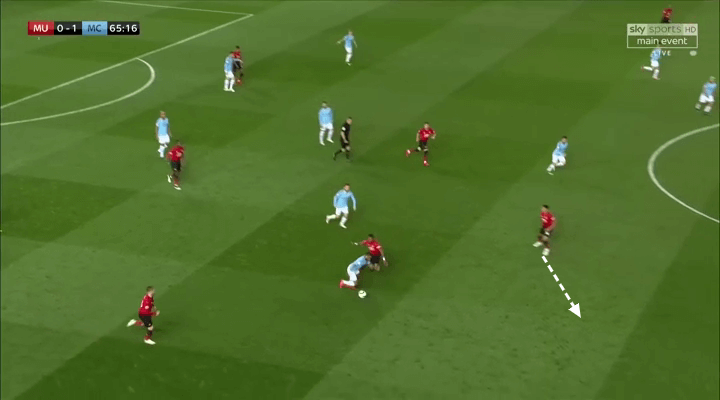
As Sterling now drives towards United’s back-three (as highlighted below), United’s three centre-backs are in really good positions.
Despite City attacking 4 vs 3, this doesn’t look all that dangerous at this point.
Amazingly, one run (Agüero’s) causes havoc for United.
It’s not even a tough run to defend against, Darmian should pass Agüero on to Smalling who can just drop and block the potential pass.
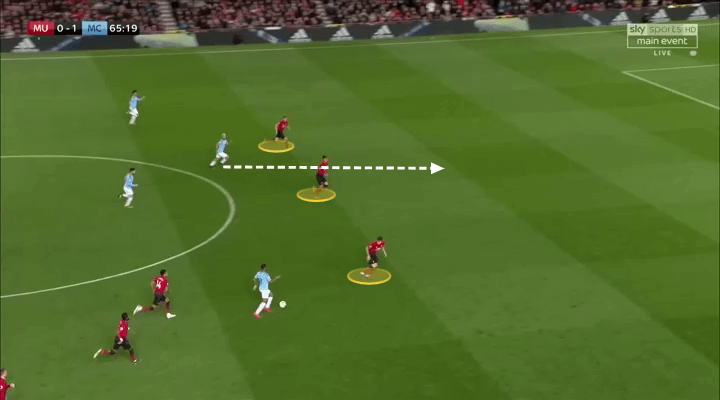
In the image below we see the scene that has been doing the rounds on social media with United’s defenders in a straight vertical line.
Instead of Darmian passing Agüero on to Smalling, the Italian followed the run as a man-orientated defender should.
This leads to the open passing lane from Sterling to Sané.
Had Darmian passed Agüero on, he could have prevented that pass from ever being made by standing in the highlighted space (yellow circle).
Now, Sané is allowed a free run at goal.
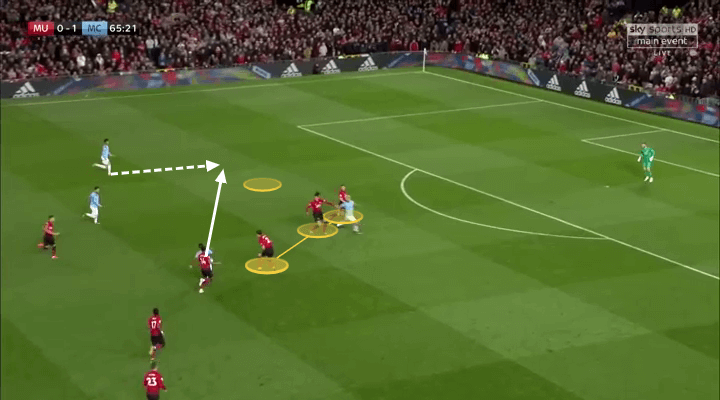
On other occasions, United have struggled not because of their players following runners, but by opting not too.
The below image highlights a situation against Watford.
You would think United have this situation under control.
There are four United players up against four Watford players.
Let’s see what happens in the next image.
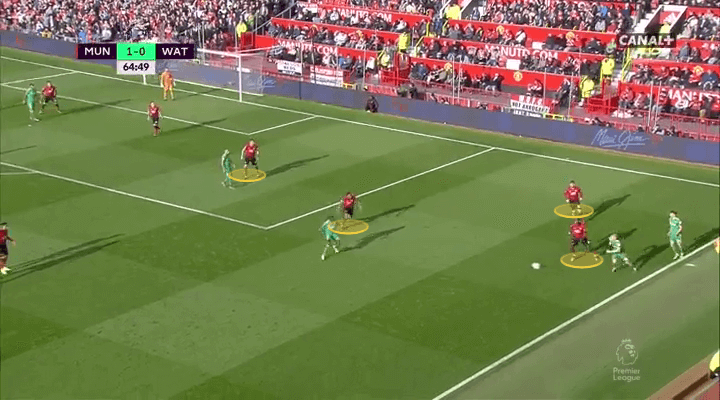
Three seconds later, Watford have exchanged a few passes and Hughes has made the highlighted run.
Look at the three United players! Pogba, who marks Hughes in the image above, is pointing to Hughes, probably urging someone to mark him when in fact that’s his job.
Kiko plays the pass into Hughes and Watford easily get into the penalty area.
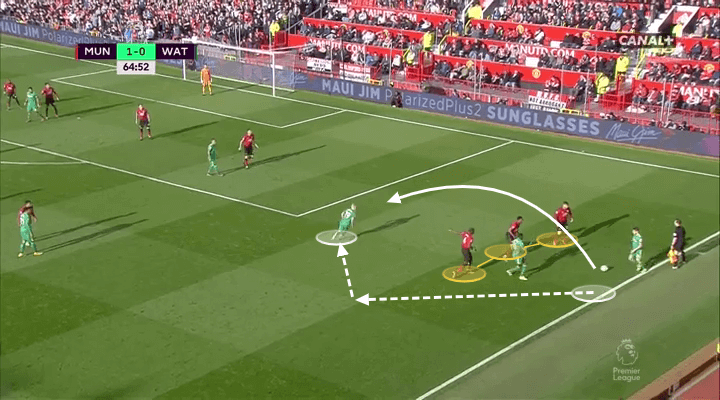
How should Solskjær solve these problems?
The easy answer is to start coaching.
Since the international break in March, when Solskjær’s interim spell was made permanent, United have been a mess.
The first game back was against Watford when United were lucky to scrape a win.
Since then, Solskjær has bemoaned the lack of time his team has had to train because of all the games they’ve played.
The reality, though, is that these defensive issues are easy to solve without high-intensive training sessions.
The fact that it’s not getting better is worrying for United.
Can Solskjær and his staff not see these issues? Do they want to defend in this reactive and chaotic manner? Previous performances (Chelsea, Liverpool and PSG away) suggest not.
In honesty, United have had their best games when given about a week between games which tells us one of two things.
The first is that United’s preparation between games when they come thick and fast is poor.
Given all their resources I find it hard to believe that.
The second is that these players have such poor decision-making in terms of defensive positioning when not meticulously preparing for a specific game plan for a week.
It also seems quite harsh on a group of players that have won World Cup’s and Premier League titles.
What seems true though, is that a lot of these players make too many individual mistakes so often that it creates a very chaotic team on the pitch.
This is something to have in mind when United recruit in the summer.
As for Solskjær, he has two more games left and will have plenty of time to train.
If United are to have a chance to finish in the top four, they need to sort their defensive issues now.
A return to the more positionally-focused defence definitely seems like the way forward for Solskjær.
If you love tactical analysis, then you’ll love the digital magazines from totalfootballanalysis.com – a guaranteed 100+ pages of pure tactical analysis covering topics from the Premier League, Serie A, La Liga, Bundesliga and many, many more.

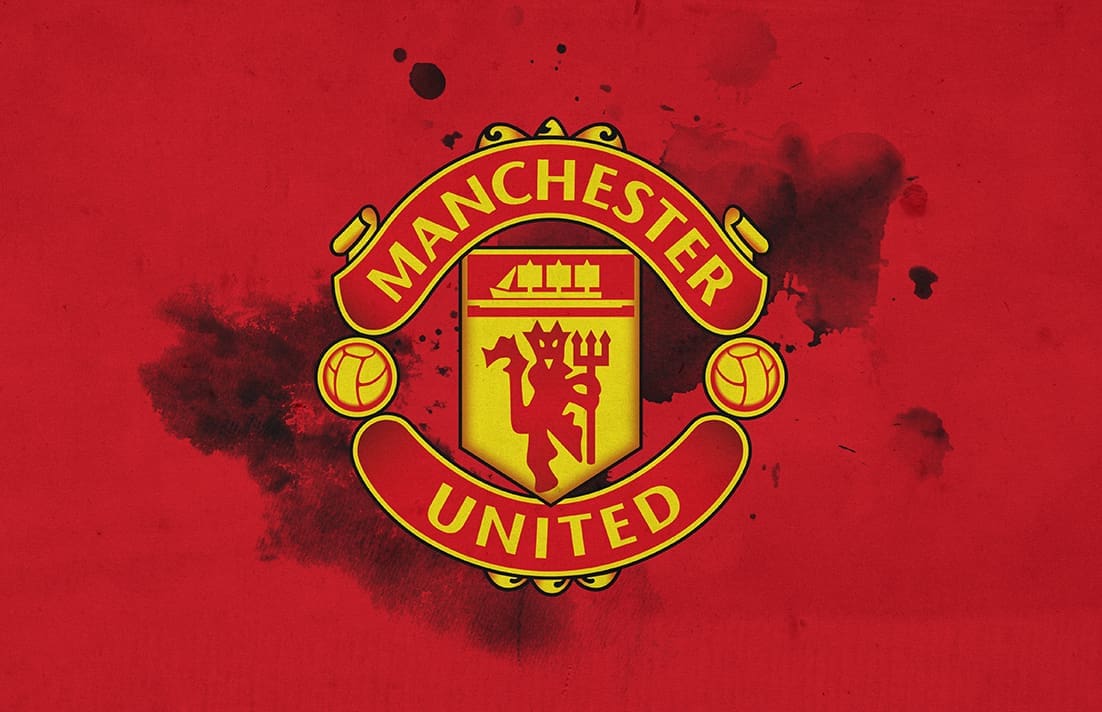



Comments